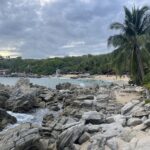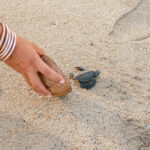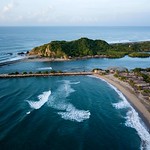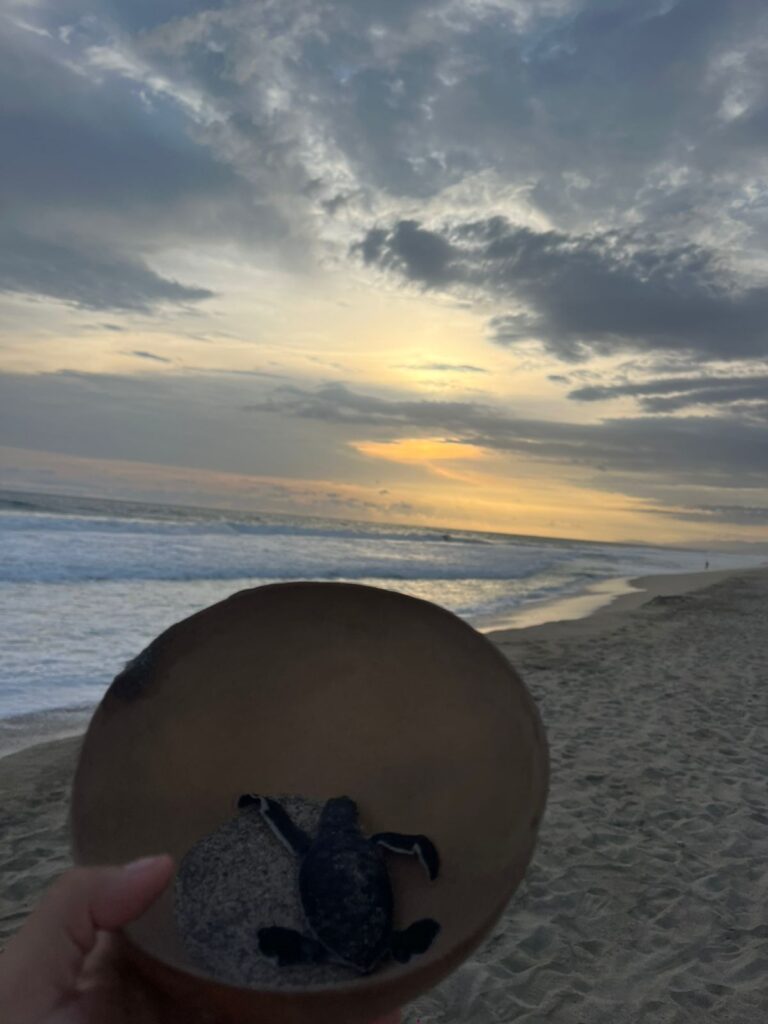
The baby turtle release in Puerto Escondido is one of the most popular things to do on the Oaxacan coast. Watching the baby sea turtles make their way into the ocean to embark on their life journey is a rewarding and thrilling experience.
Whether you wish to make your own way to one of the many camps we have mentioned below or go on a turtle release tour that will include return transfers this guide will explain everything you need to know to plan this wonderful experience.
Puerto Escondido Turtle Release FAQ
Is Releasing Sea Turtles Ethical?
The topic of turtle release is a debate not just in Puerto Escondido but worldwide. Due to increasing temperatures and poachers, the number of turtles that successfully make it to adulthood (already as little as 3%) is vastly decreasing.
One species, in particular, The Olive ridley turtle, is in danger of extinction. For this reason, the Oaxacan government and local organizations have teamed up to nurture turtle eggs to ensure they can properly hatch and begin their life journey.
There are a number of these organizations and the conservation work they are doing has been a positive impact on turtle numbers thus far.
The groups collect turtle eggs at night and put them in shaded camps to ensure they are kept at the optimal temperature.
A majority of the money that is made from a turtle release experience goes back into funding these organizations.
Where Can I Release Sea Turtles In Puerto Escondido?
At a lot of the beaches in Puerto Escondido, you will see turtle enclosures for the purpose of turtle conservation. Some of the camps where you can release baby sea turtles are as follows:
Playa Bacocho turtle release
The Playa Bacocho turtle release, also known as the baby turtle release centre, is one of the most popular places that visitors go to release baby turtles in Puerto Escondido.
To get here from the town center will cost around 80-100 pesos in a taxi and it is open daily from 5 pm and it costs 150 pesos which go to the foundation.
There is no need to arrive early, as there is usually a 40-minute wait in line to register before the beach briefing.
The registration process here can be slow and inefficient however they usually have enough turtles for everyone, peak season included.
Campamento Tortuguero Boca Barra
Campamento Tortuguero Boca Barra is a turtle-releasing camp which is located in La Barra. It is a little less frequented than the other camps and has mixed reviews.
To get to Campamento Tortuguero Boca Barra from the town center you can either grab a colectivo and then walk for 30 minutes from the main road or pay roughly 150 pesos for a taxi.
Turtle Release Vive Mar
Vive Mar actually has turtle release locations all around Puerto Escondido and the one listed on the map above is located at Palmarito beach.
The turtle release here will cost approximately 200 pesos and it is hosted daily between 5 pm and 7 pm.
The 4 species they protect are the leatherback, black, hawksbill, and Olive ridley turtle. The olive ridley turtle is present all throughout the year while the others are released between October and march.
Campamento Tortuguero Palmarito
Campamento Tortuguero Palmarito is as the name suggests located in Palmarito. They have been known to operate anywhere between 5 – 7 pm so it is recommended to contact them if you wish to make sure you are there at the right time.
They can be contacted on WhatsApp via the following number: +52 958 104 4707
What time is the turtle release in Puerto Escondido?
The time of the turtle releasing is usually 5 pm daily however it can depend on a number of different factors such as which camp you visit and when you visit.
The safest thing to do is contact the camp in advance to ensure they have baby turtles there and that the release time hasn’t changed prior to your visit.
Are there any preorganized Puerto Escondido turtle release tours?
If you experience a turtle release on your own you can expect to pay around 250 – 300 pesos with transport depending on where you’re staying in town.
An alternative option for those that wish to avoid the crowd and go on a turtle release tour can expect to pay 600 pesos per person with return transfers included.
The advantage of going with a tour is that it ensures that you are going with a company that works closely with environmental organizations.
On a tour, the guide also is bilingual and will explain all the work that the organization does as well as the importance of the turtle-releasing camps.
What are the Puerto Escondido turtle species?
Puerto Escondido is home to a number of different turtle species but the main species you’ll find here are the Olive Ridley Turtle, The brown turtle, the hawksbill sea turtle, and the leatherback sea turtle.
1. Olive Ridley Turtle (Lepidochelys olivacea)
The Olive Ridley Turtle is the smallest sea turtle and is an endangered species. Growing to lengths of 70 centimeters and weighing up to 40 kilograms, large concentrations can be found on the Oaxacan coast of Mexico.
The Olive Ridley Turtles have a bony shell and are olive in color which is where their name origin is from.
They lay eggs in large groups and there is a high population in Puerto Escondido in particular due to conservation efforts leading to success in stabilizing their numbers.
2. The brown, black, sack, parlama or torita turtle (Chelonia agassizii)
The Chelonia agassizii has many different names that it is known by such as the parlama turtle, torita turtle, sack turtle, or simply the black or brown turtle.
This turtle species is slightly larger in size than the Olive Ridley turtle, weighing up to in excess of 120 kilograms and measuring lengths of 1.2 meters.
Oddly enough the color is more green due to its predominantly algae diet.
As are all sea turtles, the Chelonia agassizii is very important to the marine ecosystem ensuring the health of reefs and other habitats.
3. The hawksbill sea turtle (Eretmochelys imbricata)
The hawksbill is a common sea turtle. Measuring between 60 and 90 centimeters they can reach weights in excess of 120 kilograms.
It is found in tropical waters around the world and is found in the waters of Puerto Escondido.
The name comes from the hawksbill-shaped beak and they are renowned for their gorgeous patterned shells which used to be the cause of them being hunted by poachers to sell, the very thing the turtle camps are set up to prevent.
4. The leatherback sea turtle (Dermochelys coriacea)
The leatherback sea turtle is the largest turtle that can reach lengths of more than 2 meters and weigh in excess of 600 kilograms.
The name originates from their shells which are a lot softer than the other sea turtle species.
They have the most efficient design allowing them to travel thousands of kilometers each year between breeding and feeding grounds while withstanding cold and rough seas.
Zipolite & Mazunte Turtle release
In addition to strolling along the beach and enjoying the refreshing sea breeze, Mazunte provides an exceptional opportunity for a unique experience: the release of sea turtles.
In support of preserving these species, the Mexican Turtle Center (known as CMT in Spanish) is situated on Mazunte Beach and stands as a vital hub for the promotion and conservation of turtles.
Within its premises, visitors can witness 3 out of the 8 sea turtle species found worldwide, along with 9 freshwater turtles and 2 land turtles, all residing in predator-free enclosures.
Playa Escobilla Turtle Release
A brief journey from Mazunte leads you to Escobilla Beach, also known as “Playa Tortuguera.” During the period from July to December, this beach transforms into an extraordinary destination, offering a breathtaking spectacle where more than 100,000 ancient sea turtles make their way ashore to lay their eggs before embarking on their voyage back into the depths of the sea.
FAQ
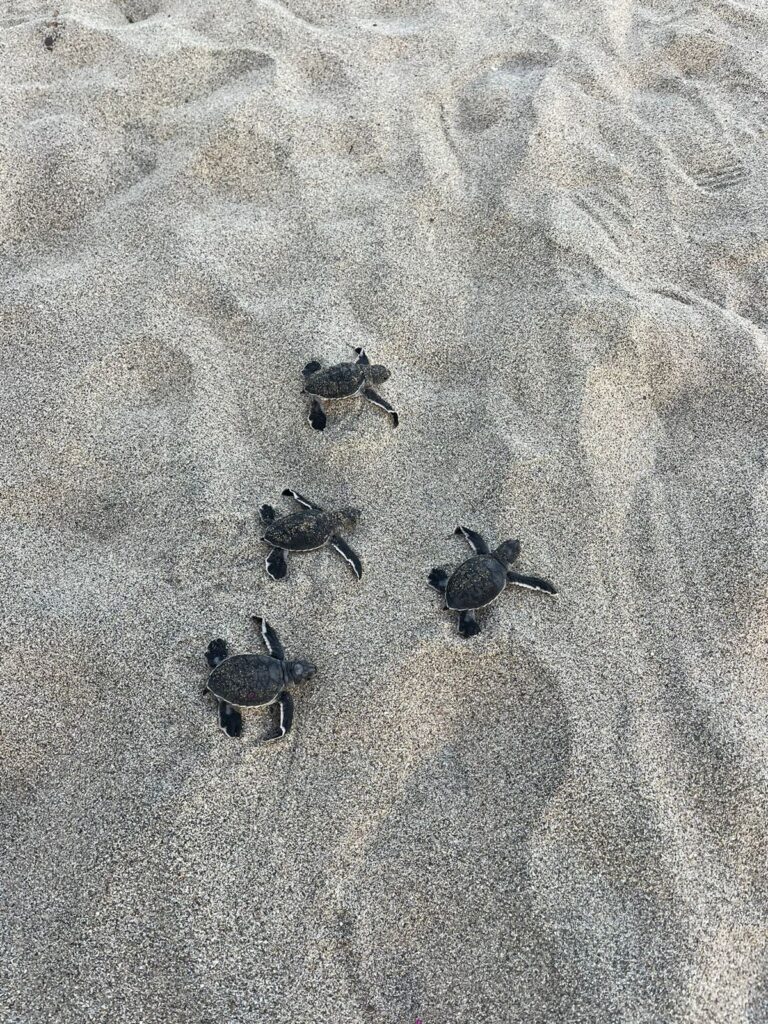
When can you release turtles in Puerto Escondido?
Certainly! You can release turtles in Puerto Escondido at any time of the year. The Olive Ridley turtle can be found here year-round. As for the Leatherback, Green, and Hawksbill turtles, their nesting season spans from October to March.
What month do sea turtles hatch in Mexico?
If you wish to experience the incredible nesting and hatching season of turtles in Mexico, the optimal time to visit is typically from late August through September and early October, although the season may occasionally extend into November.
Dusk is generally the prime time for witnessing turtle hatchings, but hatching events can also occur during the daytime.
What kind of turtles are in Puerto Escondido?
In Puerto Escondido, you can find four distinct turtle species: the Olive Ridley Turtle, the Loggerhead Turtle, the Hawksbill Sea Turtle, and the Leatherback Sea Turtle.
Each of these remarkable creatures possesses unique traits that make them a captivating sight in this picturesque town.
Is the turtle release in Puerto Escondido ethical?
At Vive Mar, the volunteers make a special effort to provide explanations about the significance of turtle releases and their role in turtle conservation.
They typically organize group discussions where visitors can learn more about the conservation efforts before participating in the release.
This allows for a deeper understanding of the work being done to protect these magnificent creatures.
Where can I release baby turtles in Puerto Escondido?
The baby turtle release in Puerto Escondido takes place daily at 5 pm on Bacocho Beach. Visitors have the opportunity to hold a tiny baby turtle, place it gently inside a coconut, and then release it into the breathtaking waters of Puerto Escondido.
Turtle Releasing In Puerto Escondido Summary
The turtle-releasing experience in Puerto Escondido is one of the most rewarding and best experiences where you can witness the beginning of a baby sea turtle’s adventure into the ocean.
There are a number of great locations to experience the activity and regardless if you do the experience on your own or go with a certified tour, we would not recommend missing out on this activity.
